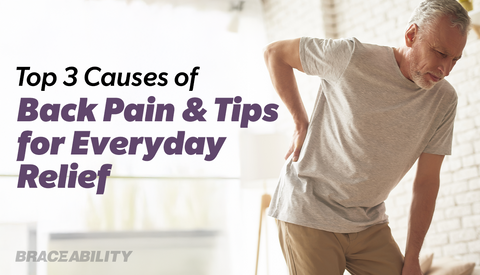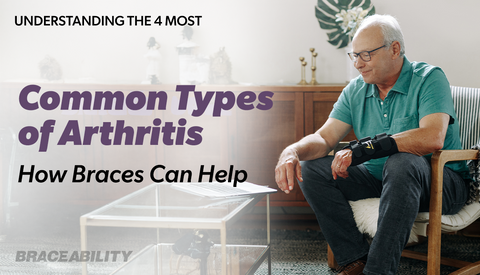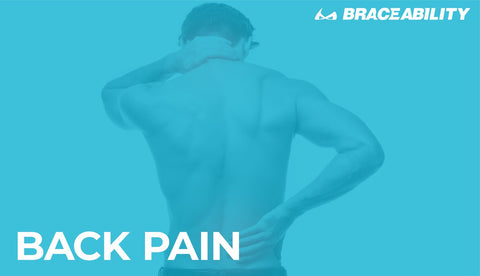Right Side Back Pain
We have all experienced back pain to some degree, but when the pain is isolated to one side, you may begin to wonder what exactly is going on. The pain you are feeling could easily represent something minor that your body will be able to take care of itself, or it could indicate a more serious condition. Read on to learn the best way to diagnose and treat your upper or lower right side back pain.
What is Causing Pain in My Upper Right Side?

Back pain is common and can occur due to many reasons, however, it can get extremely frustrating when you aren’t sure why the pain is happening or how to get rid of it. If you’re experiencing pain or discomfort in your upper right back area but can't figure out what's causing it, don't worry we're here to help!
Your upper back plays an important role in your everyday movements so it's no surprise that injuries and conditions can occur in your thoracic spine. But good news - injuries to your upper back are considerably less common in comparison to lower back injuries! The thoracic back and neck are less flexible than your lumbar spine, which is why a lot of underlying causes of right upper back pain frequently involve the internal organs that are protected by your rib cage. Since your ribs are located directly against your upper back muscles, rib cage irritation directly places stress on those muscles. Read the symptoms below to help diagnose the pain in your upper right back and get back to a pain-free life!
-
Poor Posture
"I’m experiencing roundness in my shoulder, a bend in my knees when I walk, forward/backward head leaning, back pain, muscle fatigue, headaches, and stiffness in my joints."
Practicing good posture has become more and more common due to the vast amount of desk and technology occupations that require individuals to sit at a desk for a long period of time. However, many individuals are still unaware of the importance of correcting their posture and the benefits that’ll occur if they do so. With improved posture come the health benefits such as reducing migraines, promoting weight loss, increasing your oxygen and energy levels, and more.
Signs of Poor Posture
If you are finding yourself with rounded shoulders, a sore upper neck and back, headaches, and muscle fatigue, you are likely suffering from poor posture.
Poor Posture Causes
Having poor posture is highly correlated with back and spine pain because the stress is placed on your joints, muscles, and bones in your back when your spine is in an unnatural position. Wondering what your current posture level is? Take our quick posture quiz to find out!
Treatment for Poor Posture
There are many treatment options to improve bad posture. Start by setting a posture correction routine, performing core strengthening exercises, and posture correction stretches. You can also wear a posture corrective brace, which will support a proper posture position, even while you are active throughout the day.
-
Respiratory Infection or Pneumonia
Signs & Symptoms of a Respiratory Infection
If you are experiencing chest pain along with nasal congestion, a wet or dry cough, runny nose, fatigue, body aches, and/or a sore throat you are likely experiencing a respiratory infection.
Respiratory Infection or Pneumonia Causes
Pneumonia is commonly confused with a pulled muscle because it typically causes pain in the middle back region. Back pain is related to the lungs because of the location in which your lungs lie, and the problems can be referred directly to the muscles in your upper back. It’s important to know whether you have a family history of lung issues to determine if your upper back pain is directly related to a lung problem.
Treatment Options for Respiratory Infections
To treat a respiratory infection, be sure you are taking preventative methods such as washing your hands and covering the face while sneezing and coughing. If diagnosed with pneumonia you will likely be given antibiotics/penicillin. No matter the case, make sure you are resting and drinking a lot of fluids.
-
Gallbladder Issues
"I’m experiencing sudden pain in my abdomen, discomfort between my shoulder blades, pain after eating a meal high in fat, irritation in my right shoulder, and nausea."
Signs You May Have Gallbladder Issues
The most common symptoms associated with gallbladder problems are abdominal pain, heartburn, indigestion, nausea, fever, shaking, chills, and tenderness in the upper right abdomen.
Causes of Gallbladder Issues
The gallbladder lies directly below your liver and functions as the main storage for bile produced by your liver, passing it along through a duct that empties into the small intestine. This bile helps you digest fats in your small intestine. Gallstones develop when substances in the bile, or substances from blood form hard particles that block the passageways to the gallbladder and bile ducts. The painful gallstones can also form when the gallbladder either does not completely empty or isn’t emptying often enough, likely causing you discomfort as the gallstones can be anywhere from the size of a grain of sand to the size of a golf ball.
Gallbladder Issue Treatment
Seek assistance from a doctor or medical professional to find the best treatment for you. Depending on the severity of the situation you may need surgery to remove gallstones or the gallbladder. If you are still experiencing pain after gallbladder surgery try using a post-surgical abdominal binder to help with swelling while you heal.
-
Liver Pain
“Help! I have a dull pain in my upper right abdomen, backaches in my right shoulder, and abdominal swelling.”
Signs of Liver Pain
Symptoms of liver pain vary but may include fatigue, yellowing of the skin, swelling in legs or ankles, loss of appetite, feeling full quickly after a meal, pain in the upper right abdomen, abdominal swelling.
Liver Pain Causes
The liver is located in the upper right quadrant of your abdomen, directly below your diaphragm. It’s a vital component of your body as it plays many roles such as detoxifying your body, correcting your metabolism, regulating your hormones, and more. Many different conditions could occur in your liver such as liver inflammation, fatty liver disease, liver abscess, and liver cancer. It's advised to speak with your doctor to help determine further your liver condition or problem.
Treatment Options for Liver Pain
Find what treatment option is best for you after speaking with your doctor or a medical professional. Some common remedies for liver pain include drinking a lot of fluids, avoiding fatty foods, practicing good posture while sitting, lowering cholesterol, and losing weight.
What’s Causing Pain in My Lower Right Back?

Experiencing lower back pain? Don't worry, a lot of people are. Lower back pain is extremely common due to the amount of stress and weight your lumbar spine holds. Your lower back functions as a support system when you walk, twist, turn, jump, and move around. That's why the right lower back region is prone to numerous conditions and injuries causing pain and discomfort. To help further diagnose your lower right back pain, see if any of the statements below describe your symptoms!
-
Sciatica
"I’m experiencing a sharp pain radiating down my back and one side of my buttocks or calf, pain that increases when I sit, a numbness/burning sensation, and weakness in the right side of my back."
Signs You Have Sciatica
Sciatica is best recognized as a pain that radiates from your lower spine to your buttocks and down the back of your leg. This pain can vary based on the severity of the pinched nerve, sometimes it can feel like a burning sensation while for others it can feel like a jolt or shock. You may also experience numbness or tingling in the affected leg or foot, but any of this pain should occur only on one side of your body.
Causes of a Pinched Nerve
Sciatica is a symptom of another injury and not a condition itself, confusing right? Sciatica occurs when the sciatic nerve is compressed or pinched as a result of another spinal injury such as a herniated disc, degenerative disc disease, spondylolisthesis, spinal stenosis, and SI joint dysfunction to name a few.
Sciatica Treatment
To get rid of the pain caused by a pinched nerve try physical therapy, applying hot/ice packs, exercises and stretches, anti-inflammatory medications, sciatica compression braces, or surgery depending on the severity of the condition and pain.
-
Arthritis of the Spine
Osteoarthritis Signs & Symptoms
The main symptoms associated with osteoarthritis include pain in the affected joints during or after movement, swelling, joint stiffness and tenderness, loss of flexibility, and bone spurs. You may also experience a grating sensation when the joint is in use which could result in hearing popping and crackling sounds.
Causes of Osteoarthritis
The term ‘arthritis’ refers to the swelling or inflammation in your joints. If you’re diagnosed with osteoarthritis or arthritis in your back, your facet joints have become inflamed. For every bone in your spine, you have three joints accompanying it; two facet joints and one spinal disc. These discs have a lot of stress and tension placed on them as they work to hold together your spine. This pain can make it difficult to walk and bend, causing aching discomfort. Many individuals over 50 years of age are at high risk for some sort of spine arthritis.
Treatment Options for Arthritis of the Spine
The best ways to treat arthritis in your back are to rest, apply hot/cold therapy, visit a chiropractor, use anti-inflammatory medications, and wear a medical brace for extra support.
-
Appendicitis
"I’m experiencing dull pain near my belly button, sharp pain when I move or twist my right abdomen, loss of appetite, nausea, fever, sharp pain in my right lower back, constipation, and severe cramps."
Signs of Appendicitis
Signs and symptoms of appendicitis may include pain in your lower right stomach or near your belly button that moves lower, loss of appetite, nausea, and a fever. You may also experience dull or sharp pain anywhere in your stomach, pain or difficulty urinating, or severe cramps.
Appendicitis Causes
The condition appendicitis is when your appendix becomes inflamed. Your appendix is a large tissue that connects the small intestine to the large intestine and is located on the lower right side of your abdomen. If you’re experiencing appendicitis, your appendix is inflamed and if left untreated, could burst or rupture. Appendicitis typically occurs in ages between 10 and 30 years old.
Treatment Options for Appendicitis
Treatment options for appendicitis or appendix pain include surgery to remove the inflamed appendix (appendectomy). After surgery, you should rest, support your abdomen region if you have to cough, and when ready to move around, start slowly and increase your level of activity gradually over time.
-
Kidney Issues
Kidney Pain Signs & Symptoms
The most common symptoms of kidney pain and issues include fatigue, shortness of breath, confusion, nausea, foamy urine, difficulty urinating or frequent urination, and swollen ankles or feet.
Causes of Kidney Issues
Your two kidneys function as the removal of excess fluid and waste from your body and are located in the upper abdominal area lying directly against the muscles in your back. One common cause of kidney pain is having kidney stones or kidney flank pain. Kidney stones are small mineral deposits that are formed inside of your kidneys, and when they stick together, the passing of kidney stones occurs.
Treatment for Kidney Issues
Eliminate kidney stones pain by drinking plenty of water, taking anti-inflammatory medications, using medical therapy, and getting surgery as needed for larger stones.
-
Bladder Infection
"I’m experiencing cloudy/bloody urine, the need to go to the bathroom frequently, pain or burning when urinating, and cramping or pressures in my right lower abdomen and lower back."
Bladder Infection Symptoms
Urinary tract infections don’t always cause signs and symptoms, but in the case that they do the most common include a strong urge to urinate, a burning sensation while urinating, cloudy urine, strong-smelling urine, and pelvic pain.
Causes of Bladder Infections
A bladder infection (also called UTI), occurs when there’s a bacterial infection in your bladder and is a common cause of back pain on the right side of your body. Women or females are more prone to such infections due to the length of their urethra compared to men.
Treatments for a UTI
To relieve pain caused by a bladder infection, drink a lot of water and cranberry juice, urinate frequently, take any prescribed antibiotics, apply heat to your abdomen, avoid caffeine and spicy or acidic foods, and intake foods with a large amount of vitamin C such as oranges, kale and brussel sprouts.
-
Muscle Strain, Pull or Tear
Muscle Strain, Pull or Tear Symptoms
The pain can range based on the severity of the muscle strain or tear. The most common symptoms include pain, swelling, muscle spasms, and limited ability to move the muscle. In some cases, you may experience redness, bruising, and tenderness around the affected muscle area.
Causes of Muscle Strains
Muscle strain happens when the muscles and ligaments in your body are overstretched or torn. This type of strain usually causes the area to become inflamed. This inflammation can create a lot more problems for an individual, including back spasms - which can be extremely severe.
Treatment for Muscle Tears
Eliminate pain from a strain, pull or tear by taking anti-inflammatory medications, use of muscle relaxants, getting a massage, exercising and stretching, physical therapy, use of ice/hot therapy, and using a back support brace as needed.
-
Herniated or Slipped Spinal Disc
"I’m experiencing sharp, radiating, or piercing pain in my legs and hip, numbness or tingling sensation, muscle weakness, and pain that worsens when I move."
Slipped Disc Symptoms
Most herniated discs occur in the lower back, however, signs and symptoms will differ depending on where the disc is located and whether or not it is pressing on a nerve, although it will almost always only affect one side of the body. Common symptoms include arm or leg pain, numbness and tingling, and weakness of the muscles.
Causes of a Herniated or Slipped Disc
Unfortunately, injuring your spinal discs can be a painful and confusing experience. Your doctor may diagnose your pain as a bulging disc, herniated disc, ruptured disc, or even slipped disc. While these conditions may have different names, they ultimately are a different stage or form of each other. Your spinal discs are composed of around 80% of water at birth, but as you age, you tend to lose some of this water content. For your spine to function properly, these discs must be well hydrated. When these discs lose that water content, they become less flexible, leading to a herniated disc. A herniated disc occurs when the inner core ruptures and then pushes through the crack of the outer piece.
Herniated Disc Treatment
Common treatments for a herniated disc in your spine include physical therapy, exercise, chiropractic manipulation, anti-inflammatory medications, epidural injections, surgery, and bracing.













